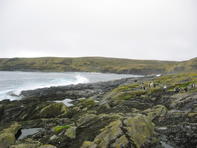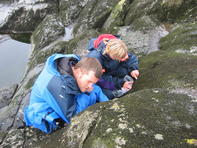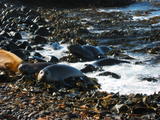Controlled Experiment of Nature
The name 'sub-Antarctic' conjures images of frozen wastes, psychedelic night-lights, twenty-four hour summer days and icebergs. On the contrary, this part of the world is comparatively mild. What makes it unique is that it is relatively constant.

Typically Marion Island, in the sub-Antarctic is pummelled by strong westerly winds all year round. Conditions are usually overcast, bright sunshine is rare, with torrents of year-round rainfall. Occasionally a deposit of snow and sleet will occur.
There is little variation in temperature. While summer may bring a 22°C high, that's about the record high, or minus 6°C in winter, the mean annual temperature is about 5°C. Summer's average is 7.3°C and winter's average is 3.2°C. Scientists get excited about a system like this.
They have a full inventory of plants and animals, including non-indigenous species that have been introduced over the centuries, and comprehensive weather records dating back over the past fifty years. It's as close to a controlled experiment as nature is going to give us. All this makes Marion Island a living laboratory for the study of climate change in the Southern Hemisphere.
The ice plateau was never formally mapped, but an estimated twenty to thirty hectares of ice covered the interior. A geomorphologist who visited the island speculated that, if the plateau were at an equilibrium thirty years ago, it is possible for that amount of ice to have melted below the surface with just a 1.5°C mean warming.
Botanic Research

Marion Island was called a jade jewel fifty years ago. Now it is a jaded jewel. Over the centuries that humans have been visiting these shores, stowaways have come with them, hidden in cargo, clothing, food and the bowels of ships. Plants, insects and mice - alien to this ecosystem - were inadvertently introduced.
For decades the cold, wet, windy climate kept their numbers in check. Growth of these foreign species did not become too invasive, but this is changing with the steady warming and drying over the past fifty years.
Dr Niek Gremmen, a specialist in sub-Antarctic botany, has been studying the island's mosses and other plants since the 1960s and has kept a careful eye on the movements of the exotic plants introduced by humans.
Sagina procumbens, a moss-like plant, was first identified in the vicinity of the research base in 1965. Back then it didn't worry researchers. Today Gremmen paints a very different picture. Between 1965 and 1975 invasive species spread by 30 to 100 metres per year on Marion Island. In the past decade, this has increased to 200 metres per year.
Now Sagina is spreading at a rate of 320 to 370 metres per year in certain places on the island. The plant was first noticed in small pockets on nearby Prince Edward Island in 1997, probably taken there by birds flying the 20 km distance between the two islands. Gremmen, who spent six days on Prince Edward in 2003, says Sagina is spreading at a rate of 600 metres per year in places.
The botanist has small research plots on Marion that he has been monitoring for years. Comparing plots of natural vegetation with those containing invasive species, Gremmen has observed that there are 50 per cent fewer indigenous species in the invaded plots.
As the climate gets warmer and drier, the conditions become more conducive to the survival of the alien plants, which hail from warmer and drier climes. Increasingly the aliens are inundating their more timid counterparts.
The Island's Natural State

In its natural state, Marion Island’s animal residents gravitate to their own exclusive suburbs. Seals and penguins tend to stay close to the shoreline.
Comfortable beaches are at a premium and that's where you will find them. Occasional seal wallows, fetid with stale water and excrement, are testimony to the nutrients they unload every time they haul out for a break from fishing. Penguin guano comes with its own nasal insult. There is plenty of fertilizer here and the plants thrive in it.
When the rains come - which they frequently do - much of this is washed back into the ocean where the algae bloom spectacularly. The zooplankton then gorge on this marine 'pasture'; fish fatten themselves on the zooplankton; and the near-shore feeding penguins feast until their numbers are bursting at the seams. It's a reliable, self-perpetuating engine.
Drier inland grass areas are difficult to reach for the swimming types. Vegetation here depends on ocean-faring birds to fly in any nutrients when they come to nest. The mires are more exclusive - what science calls a 'closed system'.
They resemble sludgy puddles and, even with a fragile mossy cap over the mud, they fail to invite nesting birds, so little nutrient supply is imported to the mires. The mires must therefore feed on themselves: the plants grow by absorbing carbon dioxide from the air, some nutrients from the slushy ground beneath, and taking in a bit of sunlight.
From this they construct their stems and leaves. If the plants were to die without passing through the gut of a herbivore - which would release the nutrients back into the soil for the plants to forage on - the dead plant material would simply accumulate in a layer of 'litter', sink down into the marsh and, over time, compact into a layer of peat.
Add a few hundred million years and coal would form. Without a constant fresh delivery of nutrients, the soil would eventually run out of the good stuff such as nitrogen and phosphorus and exhaust itself, in much the same way as a pot plant would slowly expire if its soil were not replaced or topped up with fertilizer. Slowly the mires would become worn out, sterile puddles of sludge.
But they are not barren, which clearly suggests that something else is at work here. Driving this engine onwards are the hungry mouths of a host of diminutive creatures: caterpillars and earthworms graze their way through the detritus of these mires, feeding on the litter of dead leaves, recycling the nutrients back into the soil and keeping the live plants healthy, green and wobbling over their muddy substructure.
By Leonie Joubert